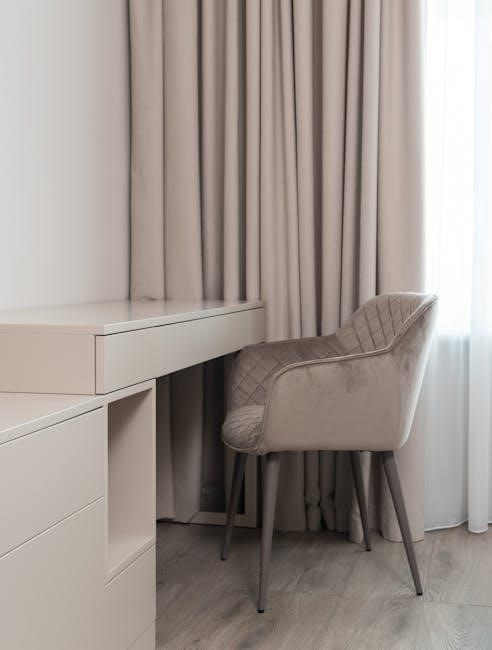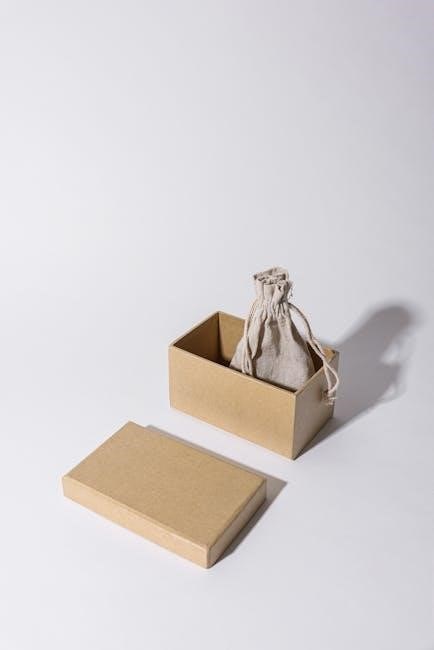Discover the charm of lined zippered pouches, perfect for organization and style. Learn how to create these versatile accessories with ease, ideal for beginners and experienced sewists alike.
1.1 What is a Lined Zippered Pouch?
A lined zippered pouch is a versatile accessory featuring an inner lining for added protection and a polished finish. Made from fabric, it includes a zipper closure and batting for structure. The lining enhances durability, prevents fraying, and offers a neat interior. Perfect for storing small items, it’s a popular DIY project, combining functionality with style. This design is ideal for beginners, offering a practical and customizable way to organize essentials.
1.2 Benefits of Adding a Lining
Adding a lining to your zippered pouch offers numerous advantages. It provides a clean, professional finish by concealing raw seams, preventing fraying, and giving the pouch a polished look. The lining protects contents from dust and abrasion, while also adding structural stability. Additionally, it allows for creative contrast, letting you customize the interior with coordinating fabrics. This step enhances both functionality and aesthetics, making the pouch more durable and visually appealing. It’s a simple yet impactful detail for any sewing project.
Materials and Tools Needed
Gather essential supplies like fabric, zippers, batting, and sewing tools. These materials ensure a professional finish and smooth construction of your lined zippered pouch.
2.1 Fabric Requirements
For a lined zippered pouch, you’ll need two contrasting fabrics: one for the outer shell and another for the lining. Choose durable materials like cotton or polyester blends. Ensure both fabrics are pre-washed to prevent shrinkage. Measure and cut pieces according to your pattern or tutorial instructions. The lining fabric should match the size of the outer fabric to ensure a seamless fit. Additionally, thin batting can be included for added structure and stability. This step is crucial for achieving a professional finish.
2.2 Zipper Selection

Choose a zipper that matches the width of your pouch design. A 20cm zipper is ideal for most standard pouches. Opt for a high-quality zipper with smooth teeth for easy opening and closing. Ensure the zipper’s color complements your fabric choices. When installing, place the zipper between the lining and outer fabric, aligning edges carefully. Use a zipper foot for precise stitching. Proper zipper placement ensures functionality and a polished appearance. Always center the zipper for a professional finish.
2.3 Notions and Batting
Gather essential notions like thread, pins, and a zipper foot for your sewing machine. Use thin batting to add structure and stability to your pouch without bulk. Cut batting slightly smaller than your fabric pieces to avoid bulky seams. Interfacing can also be used for additional stability, especially for lightweight fabrics. These materials ensure a professional finish and durability. Always pre-wash and dry batting to prevent shrinkage after sewing. Proper layering of batting and fabric is key for a smooth sewing process.

2.4 Essential Sewing Tools
A sewing machine is your primary tool for stitching, while a zipper foot helps navigate zippers smoothly. Sharp scissors or a rotary cutter and mat are indispensable for precise fabric cutting. A ruler ensures accurate measurements, and pins keep layers aligned. A seam ripper is handy for correcting mistakes. Ironing tools, like a board and iron, are essential for pressing seams and achieving a crisp finish. These tools collectively streamline the sewing process, ensuring professional results for your lined zippered pouch.

Preparing Your Fabric
Wash, dry, and iron your fabric to remove wrinkles and shrinkage. Lay it flat to ensure smooth cutting and even sewing for your lined zippered pouch.
3.1 Cutting Fabric Pieces
Cut your main fabric, lining, and batting into identical rectangular pieces. Ensure they match the zipper length for a seamless fit. Use a ruler and sharp scissors or a rotary cutter for accuracy. Smooth out wrinkles before cutting to maintain precision. If using patterns, carefully trace around them. Double-check measurements to avoid errors. Organize your pieces neatly for the next step.
3.2 Interfacing and Stabilizing
Apply interfacing or stabilizer to the main fabric for structure and durability. Place the interfacing on the wrong side of the fabric, ensuring it’s centered and smooth. Use a hot iron or steam to fuse them together, following the manufacturer’s instructions. This step prevents stretching and adds stability, especially around the zipper area. Allow the adhesive to cool before handling; Proper interfacing ensures a crisp, professional finish for your pouch.

Constructing the Pouch
Assemble the fabric, zipper, and lining, creating a sandwich. Sew the sides and bottom securely, ensuring the zipper is centered for a professional finish.
4.1 Creating the Zipper Sandwich
To create the zipper sandwich, place one piece of lining fabric face up, followed by the zipper, and then the outer fabric face down, aligning edges carefully. This layered structure ensures the zipper is securely enclosed between the lining and outer fabric, creating a polished look. Proper alignment is crucial for a professional finish and smooth functionality. Use pins to secure the layers in place before sewing.
4.2 Sewing the Sides and Bottom
With the zipper sandwich in place, sew along the sides and bottom edges using a consistent seam allowance, such as 3/8 inch. Backstitch at the beginning and end for durability. Ensure the zipper teeth are centered and the fabric lies flat. Use a zipper foot for precision. Leave a small opening to turn the pouch right side out later. This step secures the structure, creating a sturdy and professional-looking pouch. Proper alignment and even stitching are key for a clean finish.
4.3 Installing the Zipper
Installing the zipper is a crucial step that requires precision. Start by aligning the zipper with the top edge of the pouch, ensuring it is centered and the edges are matched. Use a zipper foot on your sewing machine for accuracy and sew along the prepared edge with a consistent seam allowance, such as 3/8 inch. Backstitch at both ends for added durability. Make sure the zipper is securely attached and lies flat, with the teeth visible and functional. This step brings the pouch together, creating a neat and professional finish.

Adding the Lining
Place the lining fabric face up, followed by the zipper and outer fabric right side down, aligning edges carefully. Sew together, ensuring the lining is secure and evenly distributed for a polished, functional finish.
5.1 Attaching the Lining
To attach the lining, place the lining fabric face up, followed by the zipper and outer fabric right side down. Align the edges carefully and pin in place. Sew along the top edge, ensuring the zipper is securely sandwiched between the layers. Use a 3/8-inch seam allowance and backstitch at the beginning and end for durability. Press the seams flat to create a crisp, professional finish. This step ensures the lining is evenly distributed and the pouch is fully enclosed.
5.2 Topstitching for a Finished Look
Topstitching adds a polished finish to your pouch. After attaching the lining, fold the edges outward and press. Sew a straight line along the top edge, about 1/8 inch from the seam, using a contrasting thread for a decorative touch. This step not only enhances the appearance but also reinforces the stitching. Ensure the topstitching is consistent and evenly spaced for a professional look. This detail elevates the pouch’s quality and provides a clean, finished aesthetic.

Finishing Touches
The final steps involve trimming excess seams, boxing the corners for a crisp look, and turning the pouch right side out to reveal your polished creation.
6.1 Trimming Seams
Trimming excess seam allowances ensures a clean finish. Use sharp scissors or rotary cutters to carefully cut along stitched edges, removing bulky fabric. Focus on corners and zipper ends to prevent fraying. This step is crucial for a polished look and prevents loose threads from interfering with the pouch’s functionality. A neat trim enhances the overall appearance, making your lined zippered pouch look professional and well-crafted. Ensure even cuts for a uniform finish.
6.2 Boxing the Corners
Boxing the corners adds a professional finish to your pouch. To achieve this, fold the corners of the pouch so the seams align, creating a 90-degree angle. Sew across the folded edge to secure the shape, then trim the excess fabric. This technique enhances durability and gives the pouch a crisp, defined structure. Ensure the corners are symmetrical for a polished look. Properly boxed corners prevent fraying and create a sturdy base, making the pouch more functional and visually appealing.
6.3 Turning the Pouch Right Side Out
Carefully invert the pouch through the zipper opening, ensuring the seams are pushed out for a crisp finish. Use a blunt tool like chopsticks to guide tight corners. Smooth the lining and outer fabric, making sure they align properly. Ensure the zipper is centered and lies flat. This step reveals the finished design, showcasing your handiwork. A neatly turned pouch ensures a professional look and functional durability.

Customization and Tips
Personalize your pouch with vibrant fabrics, unique zipper tabs, and creative stitching. Tips include avoiding bulky seams, using quality zippers, and adding functional details for a polished look.
7.1 Using Different Fabrics
Experiment with various fabrics to add personality to your pouch. Cotton fabrics are ideal for a soft, casual look, while laminated or vinyl fabrics offer durability and water resistance. Quilted fabrics can add texture and visual interest. For a modern touch, try mixing solid colors with bold patterns or metallic accents. Choosing the right fabric combination ensures your pouch is both functional and stylish, reflecting your personal taste perfectly.

7.2 Adding Zipper Tabs
Enhance your pouch’s functionality and style by adding zipper tabs. Use small fabric scraps to create tabs, folding them in half and placing them at the zipper ends. This adds a professional touch and makes the zipper easier to grab. Ensure the tabs are aligned with the zipper edges for a polished look. Sew securely in place during the zipper installation step for a seamless finish. This detail elevates your pouch’s usability while adding a decorative flair;
7.3 Avoiding Common Mistakes
When sewing a lined zippered pouch, ensure proper alignment of the zipper with the fabric edges to avoid uneven placement. Use a consistent seam allowance and backstitch at the beginning and end of seams for durability. Make sure the zipper is centered and the lining is evenly distributed to prevent puckering. Avoid stretching the fabric while sewing, as it can distort the pouch shape. Double-check the placement of all layers before stitching to achieve a professional finish. This attention to detail ensures a polished and functional pouch.
Creating a lined zippered pouch is a rewarding project that combines functionality with creativity. With basic sewing skills, you can craft a stylish and durable accessory perfect for organizing small items. The addition of a lining enhances both the appearance and longevity of the pouch. By following this tutorial, you’ll gain confidence in working with zippers and linings, opening the door to more complex sewing projects. Happy sewing and enjoy your handmade creations!